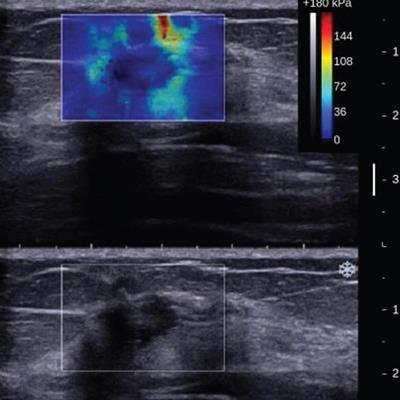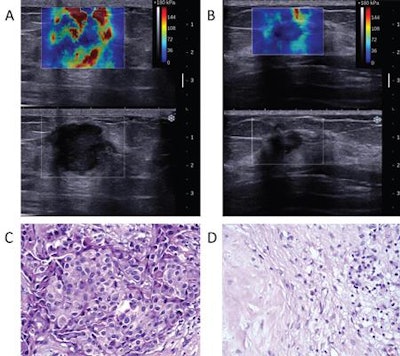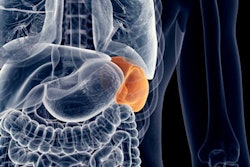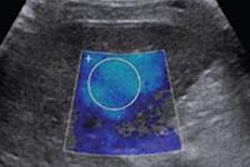
Shear-wave elastography measurements of tumor stiffness can predict early on if breast cancer patients won't respond to neoadjuvant chemotherapy, enabling clinicians to quickly switch to a different treatment strategy, according to research published in the August issue of the Journal of Ultrasound in Medicine.
In a study of more than 60 patients, a Chinese research team found that those who ultimately responded to neoadjuvant chemotherapy had much greater reduction in tumor stiffness measurements after two cycles of treatment than nonresponders. Using a defined tissue stiffness threshold cutoff value, shear-wave elastography would have yielded 72.9% sensitivity and 85.7% specificity for predicting treatment response, according to the authors.
"Early identification of the neoadjuvant chemotherapy response is crucial and can guide clinicians toward individualizing breast cancer treatments and modifying chemotherapy regimens over the treatment period, thus avoiding ineffective chemotherapies in nonresponsive patients on a timelier basis," wrote the team led by Dr. Hui Jing of the Second Affiliated Hospital of Harbin Medical University in Harbin, China.
Predicting early response
While approximately 77% of patients respond to neoadjuvant chemotherapy, those who don't respond can experience disease progression during the treatment. That delays the optimal time for surgical intervention and could increase treatment costs, according to the group. As a result, it's important to identify unresponsive tumors early and adjust treatment strategies in a timely manner to lessen unwarranted side effects from chemotherapy and improve prognoses in these patients (J Ultrasound Med, August 2016, Vol. 35:8, pp. 1619-1627).
The combination of a clinical exam and imaging modalities such as MRI, ultrasound, and mammography has been used to predict and evaluate tumor response to neoadjuvant chemotherapy. Unfortunately, it can be difficult to differentiate a surviving tumor from fibrotic scar tissue with these approaches, according to the researchers.
Previous laboratory studies of animal models have found that tumor stiffness is related to tumor progression and chemotherapeutic response. As a result, the researchers sought to investigate whether changes in tumor stiffness measurements on elastography could predict response to neoadjuvant therapy.
Their prospective study included 62 breast cancer patients who received six to eight cycles of neoadjuvant chemotherapy followed by surgical excision between October 2013 and December 2014. All patients received conventional B-mode and elastography examinations before chemotherapy and again a day before the third cycle of treatment.
One of three board-certified sonographers with five to 22 years of experience in sonography and expertise in clinical medicine and medical imaging performed the ultrasound studies at Harbin Medical University Hospital on an Aixplorer system (SuperSonic Imagine) with a 4- to 15-MHz linear array transducer. During shear-wave elastography, the mean elasticity was calculated in the stiffest area of the tumor.
Of the patients in the study, 48 (77.4%) responded to treatment and 14 (22.6%) did not. Eight patients (12.9%) were considered to have a pathologic complete response. Those who responded had a much higher percentage of tumor stiffness reduction after two rounds of treatment.
| Tissue stiffness by treatment response | ||
| Responders | Nonresponders | |
| Mean tumor stiffness at baseline | 82.763 kilopascals | 99.771 kilopascals |
| Mean tumor stiffness after two cycles of neoadjuvant chemotherapy | 50.181 kilopascals | 80.371 kilopascals |
| Mean percentage of tumor stiffness reduction | -42.194% | -23.593% |
The decrease in mean tumor stiffness was statistically significant in the responder group (p < 0.001). In addition, the difference in mean percentage of tumor stiffness reduction between the two groups was also statistically significant (p = 0.001).
 Shear-wave elastograms and corresponding pathologic images from a 59-year-old woman with breast cancer. (A) The patient's mean tumor stiffness value at baseline was 223.1 kilopascals (kPa). (B) After the second chemotherapy cycle, the mean tumor stiffness value had dropped to 44.7 kPa, representing a 77.9% reduction in tissue stiffness. (C) Before chemotherapy, the neoplastic cells showed pleomorphism with hyperchromatic nuclei, as observed under an optical microscope. (D) After surgery, the pathologic result was a complete response. The specimen showed a broad range of necrosis, fibrosis, loose tissue edema, and inflammatory cell infiltrations but was without cancer cells. Images courtesy of the Journal of Ultrasound in Medicine.
Shear-wave elastograms and corresponding pathologic images from a 59-year-old woman with breast cancer. (A) The patient's mean tumor stiffness value at baseline was 223.1 kilopascals (kPa). (B) After the second chemotherapy cycle, the mean tumor stiffness value had dropped to 44.7 kPa, representing a 77.9% reduction in tissue stiffness. (C) Before chemotherapy, the neoplastic cells showed pleomorphism with hyperchromatic nuclei, as observed under an optical microscope. (D) After surgery, the pathologic result was a complete response. The specimen showed a broad range of necrosis, fibrosis, loose tissue edema, and inflammatory cell infiltrations but was without cancer cells. Images courtesy of the Journal of Ultrasound in Medicine.After performing receiver operator characteristics (ROC) curve analysis, the researchers found that a 36.1% decrease in tumor stiffness was the optimal threshold for distinguishing between responders and nonresponders after two therapy cycles. This cutoff value yielded 72.9% sensitivity and 85.7% specificity. The area under the ROC curve for tissue stiffness was 0.802, a statistically significant result (p < 0.001). These findings indicate that measuring changes in tissue stiffness can be very useful for predicting neoadjuvant chemotherapy response, according to the researchers.
"Because it is important to avoid severe adverse effects from unnecessary chemotherapy, our proposed criteria merit consideration for patients who are nonresponsive to neoadjuvant chemotherapy to change their treatment strategies and avoid unnecessary chemotherapy," they wrote.
Clinical, pathologic characteristics
The researchers also noted some interesting findings after correlating breast cancer clinical and pathologic characteristics with tumor stiffness measurements. They found that patients with estrogen receptor (ER)-negative and progesterone receptor (PR)-negative breast cancers responded well to therapy, despite being more likely to show relatively greater tissue stiffness than patients with ER-positive and PR-positive breast cancers.
"To the best of our knowledge, there have been no published reports correlating tumor stiffness with [immunohistochemical]/molecular characteristics," the authors wrote. "Thus, laboratory studies directed at examining whether ER or PR expression is relevant to the effects of changes in tumor stiffness in response to neoadjuvant chemotherapy are sorely needed."
In future work, the researchers plan to expand upon the specific pathologic types of breast cancer included in the studies. They would also like to perform shear-wave elastography on axillary lymph nodes and increase the number of shear-wave elastography observations at the end of each chemotherapy cycle to establish real-time monitoring responses, according to the group. In addition, they hope to improve the standardization of shear-wave elastography procedures.
"Further research on [shear-wave elastography] will likely reveal greater practical applications and broader prospects for predictions or evaluations of responses to neoadjuvant chemotherapy in patients with breast cancer," the authors wrote.




















